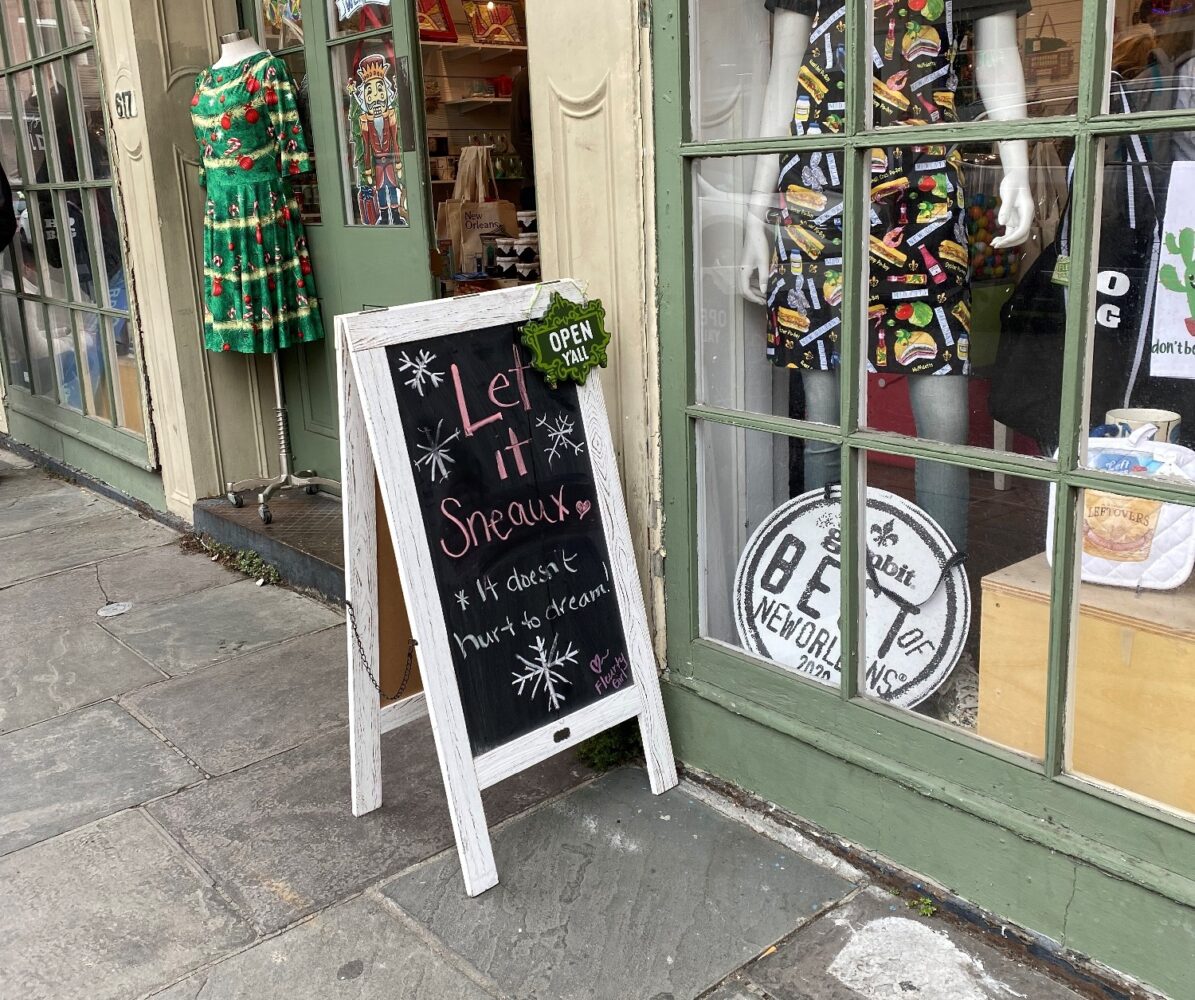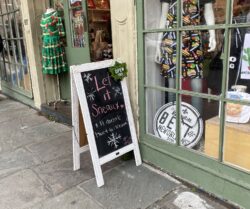Lexicon
Linguistic Kitsch
French, Yat, and other modes of speech add a je ne sais quoi to Louisiana’s culture—and marketing
Published: February 28, 2022
Last Updated: September 8, 2023

Photo by Erin Greenwald
Linguistic kitsch on display at Fleurty Girl in New Orleans.
French is the most prominent element of this linguistic kitsch, the one tourists most eagerly pay for. Swamp tour guides often make better tips if they toss in French words, even if they’re solely anglophones, according to Aalborg University linguist Christina Schoux Casey. This thirst for French is linked to whitewashed, Eurocentric notions of Cajun Louisiana as a rustic portal to history, uncorrupted by modernity. For instance, tourism nonprofit New Orleans and Company describes the history of the Cajuns, “French settlers who made their way to Canada [and] were eventually exiled and relocated to lower Louisiana in the late 1700s.” Similarly, Lafayette Travel notes that “our history dates back to the eighteenth century, when Canada’s Acadians were expelled and settled in Louisiana. More than two centuries later tourists visit for a rare taste of the genuine Acadian or ‘Cajun’ experience.” The narrative of Cajun language and culture, perfectly maintained in regional and cultural isolation, is an “amazingly stubborn” mythology, according to Nathan Rabalais, a professor of Francophone Studies at the University of Louisiana at Lafayette. This mythology veils colonial Louisiana’s place in global networks of empire and trade, including the slave trade. It also keeps Louisiana identified with France instead of Haiti and the global South. “French colonists started settling what is now maritime Canada . . . in the early 1600s,” Rabalais said, but Cajun French bears little resemblance to seventeenth-century French. “The Louisiana French we know today has much more of an affinity to nineteenth-century French, which makes sense because we kept having immigration directly from France and elsewhere in Europe . . . and then a significant influence following the Haitian Revolution.” Still, the idyll of an antimodern Acadiana is a tempting, lucrative one.
The French dialects of Acadiana are threatened, but French in New Orleans is functionally extinct. Nevertheless, in New Orleans, the language—or a replica of it—is enthusiastically commodified. In many cases, the French phrases deployed in New Orleans are idiosyncratic enough to distress Francophone tourists. Tulane anthropologist Nathalie Dajko points out that these include “Geaux,” which, according to French orthography, should be pronounced similarly to “Joe,” not “Go.” And locals proudly take liberties with the spelling of “Laissez les bon temps rouler.” These usages aren’t incorrect, and they aren’t elements of a nonstandard dialect—since French in New Orleans is extinct. They’re used to convey a sense of Frenchness, rather than purely as tools for encoding semantic meaning.If French is conjured and constructed in New Orleans, the opposite is true in nearby Indigenous communities. Most tourists (and locals) never learn that Louisiana’s most robust French-speaking populations are Indigenous. Jeffery Darensbourg, currently a Center for Louisiana Studies Fellow at UL Lafayette and a member of the Atakapa-Ishak Nation, observes that some Indigenous people in the region claim not to speak French even while it infuses their speech. This resistance to Francophone identity may come from the fact that French has, at times, been used to identify and discriminate against Indigenous speakers. This echoes the erasure white Louisiana French speakers once faced, which ironically turned to commodification with the Cajun cultural and tourism revival of the 1960s and ’70s.
Darensbourg has been instrumental in popularizing the name Bulbancha, a Choctaw term for the land where New Orleans was built, meaning “place of many languages.” Hali Dardar, a member of the United Houma Nation who co-founded Bvlbancha Public Access with Darensbourg and Ida Aronson, initially used “Bulbancha” as an educational shorthand for out-of-state visitors: she has watched it become a unifying term among Gulf Coast Indigenous groups. Today its use has spread outside of Native communities. “People ask, ‘Do you mind when white people use the word Bulbancha?’ Like, no, it’s the actual name of the place,” said Darensbourg.
Tourism, Dardar observed, can offer material motivation for Indigenous language renewal. “If you’re able to survive through your language, that might be the reason why you start learning that language,” she says. Still, she’s wary that tourist-industry monopolization can “rot out the internal product, so you’re left with the ghost.”
“Geaux,” according to French orthography, should be pronounced similarly to “Joe,” not “Go.”
Still, at present the monetary value of Louisiana French resides with the narrative of white Acadian and half-imagined New Orleans speakers, valued over Indigenous ones. A similar blend of whiteness and absence has yielded a marketable nostalgia around Yat speak. Yat, a dialect and accent associated with working-class New Orleans residents named for the expression “where y’at?”, tends to earn comparisons to New York accents because it includes features like dropped R’s and the “coil-curl” merger, causing a word like “oil” to be pronounced “earl.” Like French, Yat is barely used in Orleans Parish, at least by white people. Those speakers now live largely in the parishes surrounding the city, and face stigma within the city even while their dialect is printed on coffee mugs and T-shirts or reproduced in TV and movie representations of New Orleans. Meanwhile, Yat features remain widely used by Black speakers in New Orleans. Even so, says Casey, the features of the dialect have “now become completely associated with whiteness.” White flight, and the movement of white Yat speakers to the suburbs, perhaps led to nostalgia for those speakers—and thus to the retroactive construction of a certain white working-class Orleans Parish identity and language. Indeed, the woman on the Fleurty Girl “ya mom ‘n dem” towel is conspicuously white and midcentury-ish.
The line between performance and communication is blurry, and Frenchisms handpicked for marketing purposes have permeated everyday speech. As linguist Connie Eble has observed, tourism was behind the drive to swap “Carnival” for “Mardi Gras” and “donuts” for “beignets.” The French synonyms are now ubiquitous, especially with young people. Some might consider “beignet” a symbol of tourist industry overreach, others a triumph of dialect against standardization. But most don’t think about it at all, because it’s simply part of the lexicon.
Linguistic kitsch erases elements of regional speech and exaggerates or invents others. It also offers validation and comfort, at least to those who find their speech on T-shirts and brochures. Brands like Dirty Coast, selling in-joke–loaded New Orleans souvenirs, flourished after Katrina as people in diaspora sought reminders of home. Casey shares the story of a Black neurosurgeon who tried consciously to rid her speech of local features for professional reasons. But, the neurosurgeon explained, “I still say ‘making groceries.’” She justified the nonstandard feature by describing a notepad she owned, with the phrase “Making Groceries” printed on each page. The notepad, a piece of kitsch, lent an air of legitimacy to some of her childhood speech. But “making groceries” was the exception: most of the speech of her childhood never did get sold back to her.
Eleanor Stern is a writer of fiction and nonfiction from New Orleans and a student of Linguistics at University College London.
